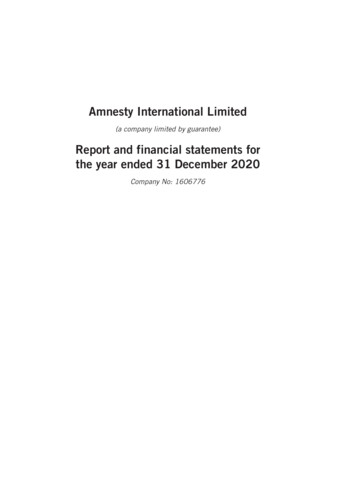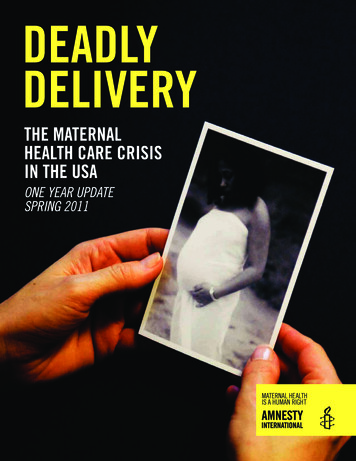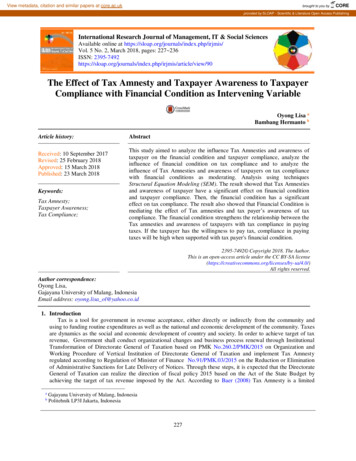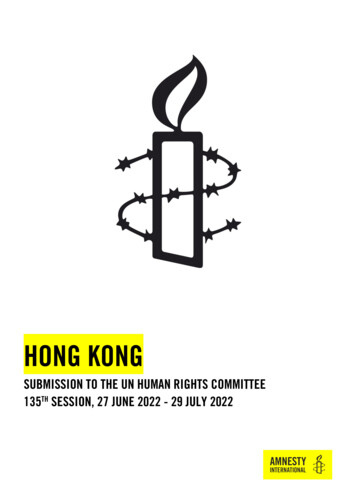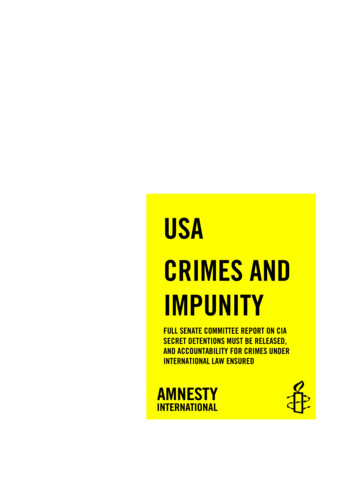
Transcription
USACRIMES ANDIMPUNITYFULL SENATE COMMITTEE REPORT ON CIASECRET DETENTIONS MUST BE RELEASED,AND ACCOUNTABILITY FOR CRIMES UNDERINTERNATIONAL LAW ENSURED
Amnesty International PublicationsFirst published in April 2015 byAmnesty International PublicationsInternational SecretariatPeter Benenson House1 Easton StreetLondon WC1X 0DWUnited Kingdomwww.amnesty.orgCopyright Amnesty International Publications 2015Index: AMR 51/1432/2015Original Language: EnglishPrinted by Amnesty International, International Secretariat, United KingdomAll rights reserved. No part of this publication may be reproduced, stored in a retrieval system, or transmitted, in any formor by any means, electronic, mechanical, photocopying, recording or otherwise without the prior permission of thepublishers.Amnesty International is a global movement of 3 millionpeople in more than 150 countries and territories, whocampaign on human rights. Our vision is for every person toenjoy all the rights enshrined in the Universal Declaration ofHuman Rights and other international human rightsinstruments. We research, campaign, advocate and mobilizeto end abuses of human rights. Amnesty International isindependent of any government, political ideology, economicinterest or religion. Our work is largely financed bycontributions from our membership and donations
Table of contentsForeword: A deafening silence on accountability . 1Summary: ‘Watch America. Watch how we deal with this’ . 2‘Do Not Open, Do Not Access’: Full report still buried . 5Black on black: redactions and classification . 7A de facto amnesty for crimes under international law . 11Recommendations . 17PART 1 – JOINING THE DOTS. 201.1 Senate Committee adds to existing picture . 201.1b Cash for disappearances. Secret sites and ‘foreign governments’ . 231.1c Involvement of Federal Bureau of Prisons in secret detention . 281.1d Death of Gul Rahman and interrogator training . 291.1e ‘Enhanced’ interrogation in CIA ‘safehouse’ . 301.1f Consequences of torture and other ill-treatment . 321.1g Waterboarding-plus. 371.1h ‘We can never let the world know what I have done to you’ . 401.1i ‘Let’s roll with the new guy’: Insights from CIA communications . 421.1j From CIA Torture to CIA Transfer to torture? . 431.1k No CIA ‘enhanced’ interrogation due to ‘US person status’ . 441.1l Lobbying other governments to hide detainees . 451.1m Little or no ‘accountability’ . 46PART 2 – TWO HUBS OF SHAMEFUL SECRETS . 482.1 Bagram and beyond: CIA detentions in Afghanistan . 482.1a Multiple detainees, multiple locations . 512.1b The case of Redha al-Najar . 562.1c What about CIA activities in Bagram? . 592.2 Confirming Guantánamo as a CIA ‘black site’ . 612.2a Rendition to torture, Guantánamo, and Morocco? . 662.2b Green to Cobalt to Guantánamo and beyond: Interrogation ‘templates’ . 692.2c Injustice compounded: A quarter of CIA detainees still at Guantánamo . 742.2d CIA retains ‘operational control’ of detainees at Guantánamo in 2006 . 79
USA: CRIMES AND IMPUNITY. Full Senate Committee report on CIA secret detentions must bereleased, and accountability for crimes under international law ensuredPART 3 – EXECUTIVE POWER AND RESPONSIBILITY .803.1 ‘Each of us must answer for what we have done’ .803.2 ‘So it begins’: President approves a disappearance .873.3 ‘Plausible deniability’ or a ‘stand-up guy’? .923.4 Green light 2003: ‘Executing administration policy’.973.4a The case of Janat Gul .1003.5 New CIA Director in 2004, crimes continue .1023.5a Abu Faraj al-Libi .1033.6 Ghost train: military/CIA disappearances 2005-2006 .1063.56a Abu Ja’far al-Iraqi and Ibrahim Jan .1073.6b Ali Jan and Hassan Ghul .1093.7 Failure to end programme after April 2006 briefing .1103.8 Executive order timed for ‘enhanced’ interrogation .1113.8a Muhammad Rahim al Afghani .113PART 4 – FAR FROM TRUTH AND JUSTICE.1164.1 Limits of Senate Intelligence Committee landmark .1164.1a What about ‘the dark side’? Rendition to ‘liaison’ custody .1174.1b Based on CIA documents provided by CIA, no interviews.1254.1c Emphasis on ‘enhanced’ interrogation techniques .1264.1d Focus on ‘effectiveness’ distracts from human rights .1284.1e No reference to a systematic crime, enforced disappearance .1314.1f Little or no reference to USA’s international obligations .1324.2 Where was Congress? .136Conclusion .139Index: AMR 51/1432/20151Amnesty International 21 April 2015
USA: CRIMES AND IMPUNITY. Full Senate Committee report on CIA secret detentions must bereleased, and accountability for crimes under international law ensuredFOREWORD: A DEAFENING SILENCE ON ACCOUNTABILITYIn the end truth will outWilliam Shakespeare, Merchant of Venice, Act 2, Scene IIThis Amnesty International report responds to a document issued by the US Senate SelectCommittee on Intelligence on 9 December 2014. That 500-page document is itself thesummary of the Committee’s report, some 13 times longer, about the programme of secretdetention operated by the Central Intelligence Agency (CIA) from 2002 to 2009 underpresidential authority granted six days after the crime against humanity committed in theUSA on 11 September 2001 (9/11). The full report remains classified Top Secret.The Committee focussed its attention on whether the programme was effective in gaininginformation from detainees and whether the CIA accurately represented to other parts ofgovernment the programme’s operational details and intelligence outputs. However, thesequestions are being asked to the exclusion of a fundamental one – when will the USA end theimpunity and stop blocking redress for the crimes under international law committed in theprogramme, as well as revealing the full truth about these human rights violations? Over fourmonths after release of the summary, the administration’s answer would seem to be “never”.Returning to the Senate Committee’s summary four months on, Amnesty International doesnot address whether the CIA programme was or was not effective, or whether an agencydescribed by a former Deputy Secretary of Defense as one that “thrives on deception” waseconomical with the truth. Rather, the organization extracts detail from the summary and setsit into a human rights frame. For the summary is not a human rights report, and makes nopretence to be. It does not assess the CIA’s conduct against the USA’s international humanrights obligations, and its overarching focus on effectiveness and CIA reporting frequentlyrelegates case details to footnotes or directs the reader to Volume III of the full report for“additional information”, which the public cannot see because it is classified.The Committee fails to mention that most or all those held in the programme were subjectedto enforced disappearance, a crime under international law. On another crime underinternational law, torture, it is left to the Chairperson in her foreword to give her “personalconclusion” that “CIA detainees were tortured”. The Committee’s collective findings avoidthe word torture, agreeing only that interrogations were “brutal and far worse”, and conditionsof confinement “harsher”, than the CIA had “represented to policymakers and others”.The summary is nonetheless an important document. It contains previously undiscloseddetails about a covert operation that was incompatible with international human rights lawfrom the outset. Yet it has been met with a deafening silence from the US administration asfar as accountability is concerned. President Barack Obama continues to ignore that issue,even though he had acknowledged before the summary was published that “we tortured somefolks” in the CIA programme. The Department of Justice, which closed its limitedinvestigations into CIA interrogations in 2012, with no charges levelled against anyone,appears to have no intention to change that state of affairs in the wake of the Committee’sfindings. Indeed its copy of the full report apparently remains unopened and unread.All branches of government must ensure their country meets its human rights obligations.Congress should press the Department of Justice to explain why it has not re-opened theinvestigation it shut down in 2012 and why it has failed to bring to justice individualssuspected of being responsible for crimes under international law. The full SenateCommittee report should be declassified and published and any use of secrecy that concealshuman rights violations or blocks accountability and redress should be ended. And measures,legislative or otherwise, to strengthen safeguards against torture and enforced disappearance,should be implemented.Index: AMR 51/1432/20151Amnesty International 21 April 2015
USA: CRIMES AND IMPUNITY. Full Senate Committee report on CIA secret detentions must bereleased, and accountability for crimes under international law ensuredSUMMARY: ‘WATCH AMERICA. WATCH HOW WE DEAL WITH THIS’Accountability for security force abuses is essential to the realization of the promise of theUniversal Declaration of Human RightsObama administration, February 20141On 9 December 2014, the US Senate Select Committee on Intelligence (Senate IntelligenceCommittee, Senate Committee) published the 500-page Executive Summary of its report onthe CIA-operated secret detention programme. Dissenting and additional views werepublished with it.2 Senator Angus King, for example, recalled what Secretary of State ColinPowell had said a decade earlier when responding to the photographic evidence of tortureand other ill-treatment perpetrated by US personnel in Abu Ghraib prison in Iraq:“Watch America. Watch how we deal with this. Watch how America will do the rightthing. Watch what a nation of values and character, a nation that believes in justice,does to right this kind of wrong.”3The world watched then as US officials sought to perpetuate the myth that what happened atAbu Ghraib could be put down to a few “bad apples”. Now it is watching how the USA dealswith the crimes under international law committed in secret detention facilities operated bythe CIA under presidential authority. When will the world see the USA end the festeringinjustices associated with its programmes of secret rendition, detention and interrogation?Another question raised by the summary is what President George W. Bush knew about theCIA detention programme being operated under authority he granted in September 2001:“In April 2006, the CIA briefed the president on the ‘current status’ of the CIA’sDetention and Interrogation Program. According to an internal CIA review, this was thefirst time the CIA had briefed the president on the CIA’s enhanced interrogationtechniques.”4Of course, even if it is true that this was the first time the CIA had briefed the President oninterrogation techniques used in a programme conceived in late 2001 and underway in early2002, it does not mean it was the first time he had been briefed at all, formally or informally,by his National Security Advisor, White House Counsel, Vice President, or other officials.While some officials are named in the summary, the identities of others have been redactedor disguised. 5 The locations of secret detention facilities or identities of collaboratinggovernments are hidden behind coding or redaction. Prior to Part 1, Amnesty Internationalemphasises the need for declassification of the full report, without any redactions thatconceal information about human rights violations, including crimes under international law.Part 1 outlines some of what the summary adds to what was already in the public realmIntroduction to the 2013 Report on Human Rights Practices, US Department of State, released 27February 2014, port/index.htm#wrapper1The summary and other materials, including additional and dissenting views of SSCI members areavailable at 3SenatorKing, additional views. Secretary of State Colin Powell, Commencement address, Wake ForestUniversity, 17 May 2004, available at tmlSSCI Executive Summary, page 158. For footnotes in this report, SSCI is used for Senate SelectCommittee on Intelligence.4The Committee “replaced the true names of some senior non-undercover CIA officials withpseudonyms. The executive branch then redacted all pseudonyms for CIA personnel, and in some casesthe titles of position held by the CIA personnel”. SSCI Executive Summary, footnote 6.5Index: AMR 51/1432/20152Amnesty International 21 April 2015
USA: CRIMES AND IMPUNITY. Full Senate Committee report on CIA secret detentions must bereleased, and accountability for crimes under international law ensuredabout this programme. In addition to detainee case details, the Senate Committee discloses avisit in 2002 by a delegation of the Federal Bureau of Prisons to a secret CIA facility inAfghanistan, provides some details on the consequences of torture and other ill-treatment ondetainees, and outlines some minimal disciplinary actions taken against CIA personnel.Part 2 looks at two of the locations used for secret detentions – Afghanistan and the US navalbase at Guantánamo in Cuba. 6 Many of the CIA detainees spent at least some of theirundisclosed detention in Afghanistan, and some new detail can be gleaned about the CIA’sactivities there. As for Guantánamo, the Senate Intelligence Committee confirms that thebase was used as a CIA “black site” in 2003 and 2004, and gives some indications as towho was held there and where they were then sent. The Senate Committee’s list of detaineesheld in CIA custody reveals that about a quarter of them are today held at Guantánamo,where the injustices of their prior treatment are compounded by ongoing indefinite detentionwithout charge, or in a few cases, subjection to a military commission system incompatiblewith international fair trial standards.It bears restating that this was not some rogue operation. This was a programme, calculatedin its construction and unlawful from day one, in which the go ahead was given to CIApersonnel to engage in acts amounting to the crimes under international law of torture andenforced disappearance, and for which impunity was envisaged early on and continues to thisday. Whether or not the programme was “effective”, and regardless of who knew what when,the USA has an obligation to reveal the full truth about the human rights violations thatoccurred, to bring to justice those responsible, and to ensure redress.There were many involved in setting the programme up and running it, or turning a blind eyeto it as evidence of abuses emerged – from senior politicians and intelligence officials, tolegislators and lawyers, to doctors and psychologists, to interrogators and guards, in the USAand elsewhere. There is clearly a profound human rights deficit at the heart of governmentwhen even senior law officers such as the Attorney General and Solicitor General activelysupport their country’s systematic use of secret detention, as the Committee indicates.Part 3 considers the involvement of executive officials in the CIA detention programme. Onthis question, Amnesty International in 2011 set out the obligations upon other countries toinvestigate former President George W. Bush for his alleged involvement in crimes underinternational law in the event he travelled to their territory.7 This report looks at what thesummary report adds in this regard, including in relation to President Bush’s involvement inapproving the rendition of Abu Zubaydah to the CIA’s first “black site”.The Senate Intelligence Committee reveals CIA concern in 2005 about congressional movesat that time towards establishing a commission of inquiry into US detentions, in particularthat any such inquiry would uncover videotapes of interrogations. No commission was everestablished and, as is well known, the CIA destroyed the videotapes in question. Part 4outlines how, as important as it is, this Senate Committee review is insufficient to dischargeUS obligations to ensure accountability for torture, enforced disappearance and otherviolations arising from the USA’s post-9/11 detention policies and practices. It also asks thequestion, where was Congress when information came into the public domain as early as2002 that the USA was using secret detention, let alone torture? Even now, the legislaturemust do more to bring the USA into line with international law on current detentions andaccountability for past violations.See also Europe: Breaking the conspiracy of silence: USA’s European ‘partners in crime’ must act afterSenate torture report, 20 January 2015, 015/en6Bringing George W. Bush to justice: International obligations of states to which former US PresidentGeorge W. Bush may travel, 2011 011/en7Index: AMR 51/1432/20153Amnesty International 21 April 2015
USA: CRIMES AND IMPUNITY. Full Senate Committee report on CIA secret detentions must bereleased, and accountability for crimes under international law ensuredAs the Committee’s summary was awaited, President Obama acknowledged that torture hadoccurred in the CIA programme, but pointed to the fear generated by the 9/11 attacks andappealed for an understanding of the task faced by law enforcement and national securitypersonnel, who “were working hard under enormous pressure and are real patriots.” 8 Ofcourse, understanding why human rights violations happen is important in ensuring they donot recur. But in the USA, “understanding” has become part of an official narrative that isinterwoven with impunity. As such, it effectively becomes justification. 9Under international law, there is no equivocation. Torture and other cruel, inhuman ordegrading treatment are never legal. Even in a time of war or threat of war, even in a state ofemergency which threatens the life of the nation, there can be no exemption from thisprohibition. The same is true of enforced disappearance.When the summary was published, a familiar note of US exceptionalism was in the air.President Obama greeted the report by saying that “one of the strengths that makes Americaexceptional is our willingness to openly confront our past, face our imperfections.” 10 Senioradministration officials added that “as Americans, we are committed to sending a clearmessage to the world that we support transparency”. 11 Yet, the vast bulk of what the SenateCommittee found about how detainees were treated remains buried in secrecy. And theadministration had itself withheld nearly ten thousand CIA documents (documents not pages).The White House denied the Senate Committee access to 9,400 CIA documents relating tothe CIA’s secret detention programme, “pending a determination and claim of executiveprivilege”. The Committee had requested these documents over “several years”, including onmultiple occasions in 2013, but had “received no response from the White House”. 12In a proclamation against torture two months after the Abu Ghraib photos were published,President Bush said that what they depicted was “inconsistent with our policies and ourvalues as a Nation.” 13 Two months after release of the Senate Committee summary, theObama administration said that “Harsh interrogation techniques highlighted in that Reportare not representative of how the United States deals with the threat of terrorism today, andare not consistent with our values.”14 Yet it would seem that for many years and for manyofficials and others, they were. Moreover it would appear that lack of truth, accountabilityand redress for crimes under international law is consistent with “national values”.All those suspected of being responsible for the commission of crimes under international lawin this programme, regardless of their level of office, must be brought to justice. Those whowere subjected to human rights violations must be given genuine access to meaningfulremedy. And the full truth about these violations must be disclosed. We are not there yet.Press conference by the President, 1 August 2004, 01/press-conference-president8USA: ‘We tortured some folks’: The wait for truth, remedy and accountability continues as redactionissue delays release of Senate report on CIA detentions, 2 September 046/2014/en9Statement by the President, 9 December 2014, tee-intelligence10Background Briefing by Senior Administration Officials on the Senate Select Committee onIntelligence Detention and Interrogation Report, 9 December 2014, ials-senate-select-commit1112SSCI Executive Summary, footnote 2.Statement on UN International Day in Support of Victims of Torture, 26 June 2004. Within days,Janat Gul (see §3.4a) was rendered to CIA custody where he was subjected to “enhanced” interrogation.13Report of the USA submitted to the UN High Commissioner for Human Rights in conjunction with theUniversal Periodic Review, 6 February 2015, para. 96, dex: AMR 51/1432/20154Amnesty International 21 April 2015
USA: CRIMES AND IMPUNITY. Full Senate Committee report on CIA secret detentions must bereleased, and accountability for crimes under international law ensured‘DO NOT OPEN, DO NOT ACCESS’: FULL REPORT STILL BURIEDThe inner envelope containing the CD remains sealed and the Department has marked theouter envelope ‘Congressional Record – Do Not Open, Do Not Access. Since receiving the CDin the Department, the contents of the disc have never been opened, accessed, or readUS Department of State, on its compact disc version of the full Senate Committee reportThe full 6,700-page Senate Intelligence Committee report has been provided to the WhiteHouse, the CIA, the Department of Justice, the Department of Defense, the Department ofState, and the Office of the Director of National Intelligence. 15 Its level of classificationappears effectively to be burying it. In the case of the Department of Defense (DoD):“The Report has not been placed within a DoD system of records, it is stored in securelocations, access to it is limited to a small number of persons with proper clearance anda need to know, and access is strictly controlled by the Under Secretary of Defense forIntelligence DoD has two copies of the full SSCI Report and both are kept in thesensitive compartmented information facilities (SCIFs). One is kept in a safe in the SCIFoffice of the Under Secretary of Defense for Intelligence. The other copy is on a standalone TOP SECRET laptop in the SCIF office of the Under Secretary’s principal legaladviser, the DoD Deputy General Counsel (Intelligence), so that she may address/adviseon litigation and other legal related matters, as necessary. Only the Deputy GeneralCounsel has access to that copy. Further, given the highly classified nature of the report,broad dissemination throughout DoD is not possible”.16The Department of State received the full report on a compact disc (CD), after which“The inner envelope containing the CD was never opened, and the CD was immediatelyplaced into a secure storage facility. It was later transferred to a secured location withinthe Bureau of Intelligence and Research (INR), which is the focal point for receiving andstoring sensitive compartmented classified information. The inner envelope containingthe CD remains sealed and the Department has marked the outer envelope‘Congressional Record – Do Not Open, Do Not Access. Since receiving the CD in theDepartment, the contents of the disc have never been opened, accessed, or read ” 17Two copies of the report were sent to the Office of Legislative Affairs (OLA), Department ofJustice (DoJ) – one for the Department and one for the Federal Bureau of Investigation (FBI):“The package was classified as ‘Top Secret/Sensitive Compartmented Information(TS/SCI) with additional classification markings for the applicable codeword SCI issometimes referred to as ‘codeword’ information, and its sensitivity requires that it beprotected in a much more controlled environment than other classified information .The two copies of the Full Report were delivered in a single package containing twodiscs [The recipient] rewrapped the copy for the FBI in the original wrapping, theinterior of which was marked TS/SCI with the applicable codeword, placed the DoJ copyin another envelope, marked it with the same classification markings, as well as ‘SenateIntel RDI Report’, and immediately placed both copies into OLA’s SCIF The copies ofthe Full Report were not distributed further and the FBI has neither retrieved norreviewed its copy of the Full Report, which remains in the OLA SCIF”.1815SSCI Executive Summary, Foreword by Senator Dianne Feinstein.16ACLU v. CIA, Declaration of Mark H. Herrington, US District Court for DC, 21 January 2015.17ACLU v. CIA, Declaration of Julia E. Frifield, US District Court for DC, 21 January 2015.ACLU v. CIA, Declaration of Peter J. Kadzik, US District Court DC, 21 January 2015. See also FBIchief is not sure where ‘torture report’ is. The Hill, 12 March 2015,18Index: AMR 51/1432/20155Amnesty International 21 April 2015
USA: CRIMES AND IMPUNITY. Full Senate Committee report on CIA secret detentions must bereleased, and accountability for crimes under international law ensuredThe Senate Intelligence Committee’s then Chair, Senator Dianne Feinstein, expressed thehope in her foreword to the summary that distributing the report to these various departmentswould “prevent future coercive interrogation practices and inform the management of othercovert action programmes”. In contrast, the new Chairperson, Senator Richard Burr, isreported to have called on the various departmental recipients of the report to return thecopies.19 Senator Burr was one of the Committee members to sign the minority (dissenting)report, which argued that the review amounted to an attack on “the CIA’s integrity andcredibility in developing and implementing the Program”, and created “the false impressionthat the CIA was actively misleading policy makers” during the programme’s lifetime.On 21 January 2009, the day before he ordered an end to the Guantánamo detentions withina year and for the CIA to “close as expeditiously as possible any detention facilities that itcurrently operates”, President Obama issued a memorandum proclaiming:“My administration is committed to creating an unprecedented level of openness inGovernment Transparency promotes accountability and provides information forcitizens about what their Government is doing”. 20The summary rightly states that the Committee’s study – begun in March 2009, completed inDecember 2012, and updated in 2014 – is “the most comprehensive review ever conductedof the CIA’s Detention and Interrogation Program”. 21 Although important, the summaryreveals only a small part of what the Committee found in relation to the abuse of detain
or disguised.5 The locations of secret detention facilities or identities of collaborating governments are hidden behind coding or redaction. Prior to Part 1, Amnesty International emphasises the need for declassification of the full report, without any redactions that conceal information about human rights violations, including crimes under .
